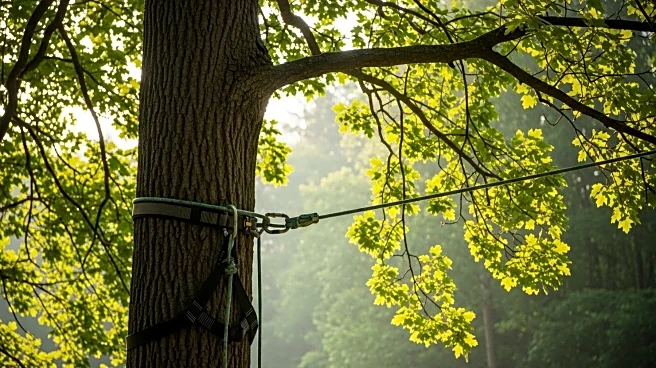What's Happening?
The Forest Industry Safety Accord (FISA) has released updated guidance on the use of tree jacks, emphasizing the need for chainsaw technicians to be highly skilled and trained in jacking procedures. The updated technical note from FISA's Chainsaw Working Group outlines key considerations for handcutters before implementing the technique. Tree jacking involves causing a controlled fall of a tree against its natural lean, providing a mechanical advantage over traditional methods like wedges. However, it also introduces additional hazards if not properly assessed and planned. The guidance specifies that jacking should only be performed by technicians trained in the procedure, with trainees under close supervision. The document highlights potential hazards such as failure of the tree to fall or loss of control over its direction, often due to improper assessment or defects in the tree or stump.
Why It's Important?
The updated guidance from FISA is crucial for ensuring safety in forestry operations, particularly for chainsaw technicians who face significant risks when felling trees. By emphasizing the need for proper training and assessment, FISA aims to reduce accidents and improve operational efficiency. This guidance impacts the forestry industry by potentially lowering the incidence of workplace injuries and fatalities, which can have economic implications for companies due to reduced downtime and liability costs. Additionally, it underscores the importance of skilled labor in maintaining safety standards, which could influence training programs and certification processes within the industry.
What's Next?
Forestry companies and chainsaw technicians are expected to integrate the updated guidance into their operational protocols. This may involve revising training programs to ensure technicians are adequately prepared for jacking procedures. Companies might also conduct assessments to identify technicians who require additional training or supervision. As the industry adapts to these changes, there could be increased demand for competent jack technicians, potentially influencing hiring practices and workforce development strategies. Stakeholders, including safety regulators and industry associations, may monitor the implementation of these guidelines to evaluate their effectiveness in reducing accidents.
Beyond the Headlines
The emphasis on skilled labor and proper training in the updated guidance reflects broader trends in the forestry industry towards enhancing safety and operational standards. This shift may lead to long-term changes in how forestry operations are conducted, with a focus on minimizing environmental impact and improving worker safety. The guidance also highlights the ethical responsibility of companies to ensure the safety of their employees, which could influence corporate policies and industry regulations. As the industry evolves, there may be increased collaboration between safety organizations and forestry companies to develop innovative solutions for risk management.










